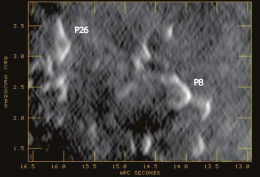Could stars be forming in the inhospitable environment near Sagittarius A* in the heart of the Milky Way? A possible signature of low-mass star formation has recently been found just two light-years from the black hole at the center of our galaxy — a region that was previously thought to be too hostile for such activity.
Searching for Signatures
Previous observations of the central few light-years of the Milky Way had focused on a population of about 200 massive, young and very bright stars in tight orbits around Sgr A*. These stars are only a few million years old and prompted scientists to wonder: have they somehow managed to form in situ, in spite of their close proximity to the black hole, or did they form further out and then migrate in?
Motivated by this mystery, Farhad Yusef-Zadeh of Northwestern University and collaborators looked for evidence of even younger stars close to Sagittarius A*, which would demonstrate that star formation in the area is an ongoing process. Using the Very Large Array (VLA), the collaboration discovered several small sources in one arm of activity near Sgr A*.

This 34-GHz image provides a close-up view of two protoplanetary disk candidates (labeled P26 and P8) located near Sgr A*. These objects are outlined on the right side by a bow shock caused by impacting stellar wind that streams from the young, hot stars closer to the Galactic center. The disks are thought to contain recently-formed, low-mass stars. (Credit: Yusef-Zadeh et al., 2015)
Heated Disks
The team identified these sources as candidate photoevaporative protoplanetary disks, or “proplyds” — areas of dense, ionized gas and dust surrounding young, newly formed stars. The proplyd candidates are between 10,000 and 100,000 years old, and they lie along the edge of a large molecular cloud. It is likely that this cloud produced the disks by providing a reservoir of gas to feed the star-formation activity.
The region surrounding these proplyds is blasted with harsh ultraviolet radiation streaming from hot stars orbiting close to Sgr A*. The gas of the proplyds is heated and stripped away by this radiation, forming bow shocks around the disks. Both the proplyds themselves and the bow shocks surrounding them are visible in Yusef-Zadeh’s observations.
Potential for Planet Formation
Unlike the young massive stars that have previously been identified in the galactic center, the proplyd candidates in this study are associated with low-mass stars. This has led to speculation that it may in fact be easier for low-mass stars to form in the hostile surroundings of the black hole than it is for them to form elsewhere in the Milky Way. In addition, the rate at which material is lost from such proplyds is expected to be low, so there is a chance for the disk to eventually form planets. With that comes the tantalizing possibility that as telescope resolution and data-analysis techniques improve, we may even be able to watch planet formation occur near Sgr A*.
Citation
F. Yusef-Zadeh et al. 2015 ApJ 801 L26 doi:10.1088/2041-8205/801/2/L26
Bonus:
Check out the authors’ video abstract below, which shows the locations of the proplyd candidates relative to Sgr A* and provides more information about how the observations were made and analyzed.

